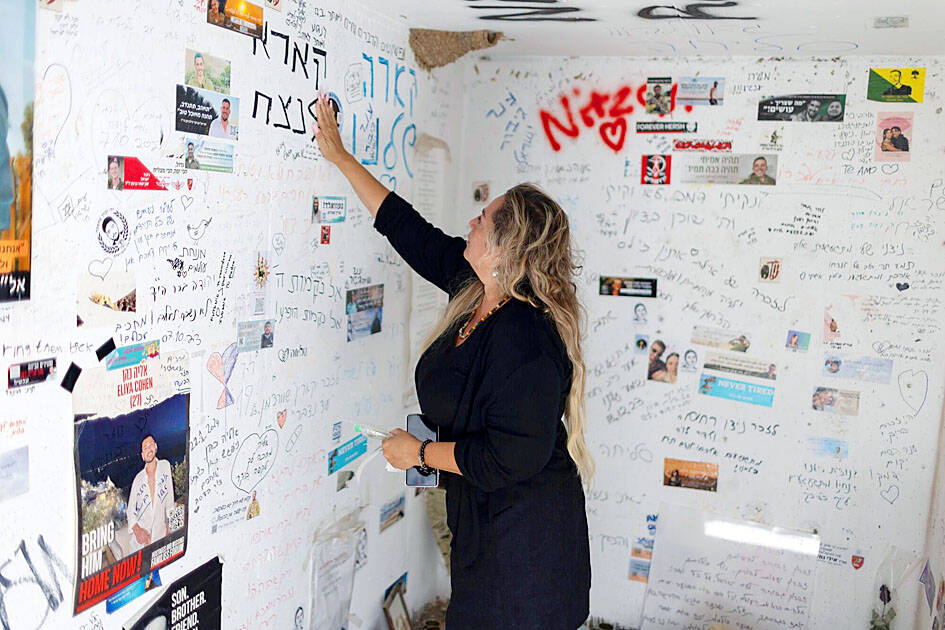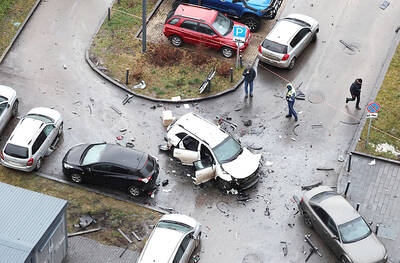Thousands of people yesterday converged in southern Israel to mourn the dead as the nation marked two years since Hamas’ Oct. 7 attack plunged the region into a devastating war, while Israel and Hamas pressed on with indirect peace talks in Egypt.
The main memorial in Tel Aviv, planned for later in the evening and organized by the bereaved families, is separate from a ceremony that the government is to hold on the anniversary next week according to the Hebrew calendar.
The split in the ceremonies reflects deep divisions over Israeli Prime Minister Benjamin Netanyahu ’s leadership, which many blame for the failure to secure a ceasefire that would free the remaining hostages held by the militants.

Photo: Bloomberg
In the Gaza Strip, where Israel’s retaliatory offensive has killed tens of thousands of people and razed entire towns and cities, those who can are fleeing another Israeli invasion of Gaza City while others are sheltering in place. Many are unable to make the arduous and costly journey south.
It has been two years since thousands of Hamas-led militants poured into southern Israel after a surprise barrage of rockets. They stormed army bases, farming communities and the Nova outdoor music festival, killing about 1,200 people, mostly civilians, including women, children and older adults. They abducted 251 others, most of whom have since been released in ceasefires or other deals. Forty-eight hostages remain inside Gaza, about 20 of them believed by Israel to still be alive.
Although there was no official ceremony at the Nova site, due to the Jewish holiday of Sukkot that coincides with the anniversary, thousands of people visited throughout the day to share memories of relatives and friends who were killed, weaving through hundreds of photos encircling the spot where a DJ booth stood.

Photo: Reuters
In Egypt, peace talks between Israel and Hamas resumed at the Red Sea resort of Sharm el-Sheikh, focused on a plan proposed by US President Donald Trump last week that aims to bring about an end to the war.
After several hours of talks on Monday, an Egyptian official with knowledge of the discussions said the parties agreed on most of the first-phase terms, which include the release of hostages and establishing a ceasefire. The official, who spoke on condition of anonymity, said the talks resumed yesterday afternoon.
Egyptian Minister of Foreign Affairs Badr Abdelatty told journalists that members of the US delegation would join the talks today.

TRAGEDY STRIKES TAIPEI: The suspect died after falling off a building after he threw smoke grenades into Taipei Main Station and went on a killing spree in Zhongshan A 27-year-old suspect allegedly threw smoke grenades in Taipei Main Station and then proceeded to Zhongshan MRT Station in a random killing spree that resulted in the death of the suspect and two other civilians, and seven injured, including one in critical condition, as of press time last night. The suspect, identified as a man surnamed Chang Wen (張文), allegedly began the attack at Taipei Main Station, the Taipei Fire Department said, adding that it received a report at 5:24pm that smoke grenades had been thrown in the station. One man in his 50s was rushed to hospital after a cardiac arrest

A car bomb killed a senior Russian general in southern Moscow yesterday morning, the latest high-profile army figure to be blown up in a blast that came just hours after Russian and Ukrainian delegates held separate talks in Miami on a plan to end the war. Kyiv has not commented on the incident, but Russian investigators said they were probing whether the blast was “linked” to “Ukrainian special forces.” The attack was similar to other assassinations of generals and pro-war figures that have either been claimed, or are widely believed to have been orchestrated, by Ukraine. Russian Lieutenant General Fanil Sarvarov, 56, head

SAFETY FIRST: Double the number of police were deployed at the Taipei Marathon, while other cities released plans to bolster public event safety Authorities across Taiwan have stepped up security measures ahead of Christmas and New Year events, following a knife and smoke bomb attack in Taipei on Friday that left four people dead and 11 injured. In a bid to prevent potential copycat incidents, police deployments have been expanded for large gatherings, transport hubs, and other crowded public spaces, according to official statements from police and city authorities. Taipei Mayor Chiang Wan-an (蔣萬安) said the city has “comprehensively raised security readiness” in crowded areas, increased police deployments with armed officers, and intensified patrols during weekends and nighttime hours. For large-scale events, security checkpoints and explosives

PUBLIC SAFETY: The premier said that security would be tightened in transport hubs, while President Lai commended the public for their bravery The government is to deploy more police, including rapid response units, in crowded public areas to ensure a swift response to any threats, President William Lai (賴清德) said yesterday after a knife attack killed three people and injured 11 in Taipei the previous day. Lai made the remarks following a briefing by the National Police Agency on the progress of the investigation, saying that the attack underscored the importance of cooperation in public security between the central and local governments. The attack unfolded in the early evening on Friday around Taipei Main Station’s M7 exit and later near the Taipei MRT’s Zhongshan